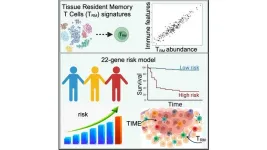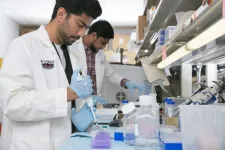(Press-News.org) Parents often worry about the use of social media among children and young people. Caring about this is a good thing, and there are several reasons why you should pay attention, but there is one thing that parents needn’t worry about: young people spending time on social media does not impair their interaction with friends offline, according to a new study.
“On the contrary, we find that people who use social media a lot spend more time with friends offline,” says Professor Silje Steinsbekk at the Norwegian University of Science and Technology (NTNU’s) Department of Psychology.
The results are based on data from a long-term project called the Trondheim Early Secure Study. Data were collected from approximately 800 children and young people when they were 10, 12, 14, 16 and 18 years old.
Among other things, the researchers asked the following question: If children spend more time using social media, will their social skills get better or worse and will they spend less or more time with friends offline?
Important to know more about the use of social media
Social interaction with friends is important in itself. It is associated with good mental health and is important because it provides the opportunity to practise social skills.
“Social media is a new arena for social interaction, and some people have argued that the use of social media inhibits the development of social skills, while others have claimed the opposite: that social media can promote social skills. We did not find any evidence supporting one or the other,” says Steinsbekk.
She says it is important to know which people are particularly vulnerable to problematic use of social media and who can benefit from it. The researchers therefore also investigated whether age, gender, the quality of friendship, and symptoms of social anxiety played a role.
Children with social anxiety may be at risk
The researchers found that children with symptoms of social anxiety who use social media a lot over time are at risk of developing poorer social skills.
“This correlation was weak, so we are reluctant to draw strong conclusions until more research has been done to investigate this further,” says Steinsbekk.
Previous research has shown that people with social anxiety may find it less intimidating to communicate with others online than in real life, and that these individuals therefore actually benefit from social media. However, other studies show that they are also more vulnerable to problematic use of social media, such as increased risk of addiction and intensive use.
A challenging field of research
“Social media is a new social landscape where children and young people spend a lot of time, and we need knowledge about how it affects them. The findings of this study do not support the assumption that increased use of social media leads to less time spent together with friends. In fact, they suggest the opposite,” says Steinsbekk.
Children who spend more time using social media report spending several evenings a week with friends offline.
Other studies have shown that the use of social media leads to increased closeness in friend relationships, the development of new friendships, and old friendships being reinforced. This may be a possible explanation for the findings from the Trondheim Early Secure Study.
“We hope the findings can help reduce parents’ concerns somewhat. At the same time, it is important to emphasise the rapid pace of technological developments, which makes it challenging to research social media use. It is impossible to know if the results would be the same if we studied today’s 10-year-olds and followed them until they turned 18 in 2032,” says Steinsbekk.
Reference: Silje Steinsbekk, Oda Bjørklund, Patti Valkenburg, Jacqueline Nesi, Lars Wichstrøm, The new social landscape: Relationships among social media use, social skills, and offline friendships from age 10–18 years, Computers in Human Behavior, Volume 156, 2024, 108235, ISSN 0747-5632, https://doi.org/10.1016/j.chb.2024.108235. (https://www.sciencedirect.com/science/article/pii/S0747563224001031
END
The people who are most active on social media are also the most active offline
It can be worrisome to see your child glued to their phone, constantly chatting with friends and making videos. But new research shows these kids also spend more time with friends offline.
2024-05-02
ELSE PRESS RELEASES FROM THIS DATE:
Climate is one culprit in spread and growth of dust in Middle East
2024-05-02
Climate change is transforming dust storms—a natural phenomenon in the Middle East—into a more frequent and widespread threat to health and economies throughout the region, a new study shows.
Dust levels have increased in many parts of the Middle East chiefly due to global warming, but other human activities also share credit, says Zahra Kalantari, associate professor at KTH Royal Institute of Technology. She cites such factors as oil extraction, military conflicts and lack of cross-border ...
Gene signatures from tissue-resident T cells as a predictive tool for melanoma patients
2024-05-02
(LOS ANGELES) – May 2, 2024 - An extensive analytical study conducted at the Terasaki Institute for Biomedical Innovation (TIBI) has revealed an association between favorable survival outcomes for melanoma patients and the presence of higher populations of tissue-resident memory T cells (TRM). Data obtained from this study could be used not only for a TRM-based machine learning model with predictive powers for melanoma prognosis but could also elucidate the role TRM cells can play in the tumor immune microenvironment. This could guide the development of more effective and personalized anti-tumor immunotherapeutic treatment regimens for cancer ...
FAU creates new Department of Biomedical Engineering
2024-05-02
In recognition of a rapidly growing field, Florida Atlantic University’s College of Engineering and Computer Science (COECS) has created a Department of Biomedical Engineering. The newly established department will focus on three key areas: biomaterials and tissue engineering; smart health systems; and bio-robotics. Biomedical engineering integrates fundamental and practical concepts in electrical and mechanical engineering, biology, computer science and medicine into a cross-disciplinary field focused on improving human health and solving problems in the delivery of health care.
The COECS faculty are already performing ...
Program announced for NUTRITION 2024 to be held June 29–July 2
2024-05-02
Reporters are invited to join leading nutrition researchers and professionals at NUTRITION 2024, the annual flagship meeting of the American Society for Nutrition. The meeting will bring together thousands of experts from around the globe to share and discuss emerging scientific and policy developments in food, nutrition and public health June 29–July 2 in Chicago.
The meeting program features exciting scientific symposia, award lectures, networking events and more, offering an up-close view into the latest findings, opportunities and debates. More than 1,600 original research studies will be presented ...
A link between breast changes and … UTIs?
2024-05-02
Women’s health is often talked about in terms of major, life-altering events like pregnancy and menopause. A new study from Cold Spring Harbor Laboratory (CSHL) underscores the importance of considering everyday occurrences’ impact on women’s well-being.
CSHL researchers have made a surprising discovery involving urinary tract infections (UTIs). The scientists found that UTIs in mice can provoke a bodily response that results in structural changes in breast tissue. Remarkably, these changes are reversible ...
Researchers create new chemical compound to solve 120-year-old problem
2024-05-02
MINNEAPOLIS/ST. PAUL (05/02/2024) — For the first time, chemists in the University of Minnesota Twin Cities College of Science and Engineering have created a highly reactive chemical compound that has eluded scientists for more than 120 years. The discovery could lead to new drug treatments, safer agricultural products, and better electronics.
For decades, researchers have been investigating molecules called N-heteroarenes, which are ring-shaped chemical compounds that contain one or more nitrogen atoms. Bio-active molecules having a N-heteroarene core are widely ...
Four state-of-the-art, artificial intelligence search engines for histopathology images may not be ready for clinical use
2024-05-02
Four proposed state-of-the art image search engines for automating search and retrieval of digital histopathology slides were found to be of inadequate performance for routine clinical care, new research suggests.
The performance of the artificial intelligence algorithms to power the histopathology image databases was worse than expected, with some having less than 50% accuracy, which is not suitable for clinical practice, said Dr. Helen Shang, a third-year internal medicine resident and incoming hematology-oncology fellow at the David Geffen School ...
Young adults reduced drinking during and after pandemic
2024-05-02
A new study examined the drinking levels and patterns of young adults before, during and after the pandemic. The researchers found alcohol use and alcohol-related problems substantially decreased in heavy-drinking young adults during the pandemic, and these decreases were still evident as the pandemic began to wane. The results are available in the May 2 issue of the journal Nature Mental Health.
“The pandemic gave us a unique opportunity to see how wide-spread mitigation measures like social distancing and bar/restaurant closures may have affected alcohol consumption,” said lead ...
Random robots are more reliable
2024-05-02
Northwestern University engineers have developed a new artificial intelligence (AI) algorithm designed specifically for smart robotics. By helping robots rapidly and reliably learn complex skills, the new method could significantly improve the practicality — and safety — of robots for a range of applications, including self-driving cars, delivery drones, household assistants and automation.
Called Maximum Diffusion Reinforcement Learning (MaxDiff RL), the algorithm’s success lies in its ability to encourage robots to explore their environments as randomly as possible in order to gain a diverse set of ...
Why do male chicks play more than females? Study finds answers in distant ancestor
2024-05-02
Play is widespread, but far from ubiquitous, across the animal kingdom. Especially common in mammals, play is also known to occur in taxa as diverse as birds, fish, octopuses, and even insects. But what is its function, given that natural selection never selects fun for its own sake? One prominent hypothesis is that play is beneficial to individuals because it allows them to practice skills needed later in life.
Now, a study in Frontiers in Ethology has shown that male baby chickens play far more than females. This result is of interest given that domestic ...
LAST 30 PRESS RELEASES:
Membrane magic: FAMU-FSU researchers repurpose fuel cells membranes for new applications
UN Member States pledge to increase access to diagnosis and inhaled medicines for the 480 million people living with COPD
Combination therapy shows potential to treat pediatric brain cancer ATRT
Study links seabird nesting to shark turf wars in Hawai‘i
Legal sports betting linked to sharp increases in violent crime, study finds
Breakthrough AI from NYUAD speeds up discovery of life-supporting microbes
New Eva Mayr-Stihl Foundation funding initiative boosts research at University of Freiburg on adaptation of forests to global change
The perfect plastic? Plant-based, fully saltwater degradable, zero microplastics
Bias in data may be blocking AI’s potential to combat antibiotic resistance
Article-level metrics would provide more recognition to most researchers than journal-level metrics
Satiety’s little helper: Protein that supports appetite regulating protein identified
UF dives deep into predicting storm damage with computer models
A stormy ocean voyage yields insights on the global carbon cycle
Scientists identify first non-coding gene that controls cell size
Demonstration of altermagnetism in RuO₂ thin films -- A new magnetic material for the AI era
Penn researchers awarded $25M to conduct trial using smartphones to fight heart disease
PCORI awards funding for new patient-centered healthcare research
Exploring the origins of the universe: 145 low-noise amplifiers complete ALMA telescopes
Empress cicada wings help illuminate molecular structure
Using sound waves to detect helium
Time burden in patients with metastatic breast and ovarian cancer from clinic and home demands
Researchers discover bias in AI models that analyze pathology samples
Scientists ID potential way to prevent brain injuries from triggering Alzheimer's
MASTER 2nd Open Call: Execution period kick-off
Algae for health in food and pharma
Advanced microrobots driven by acoustic and magnetic fields for biomedical applications
Chicago health information leader recognized for raising CPR readiness and blood pressure awareness
The Intimate Animal, a new book from Kinsey Institute Executive Director Dr. Justin Garcia
When blue-collar workers lose union protection, they try self-employment
New video dataset to advance AI for health care
[Press-News.org] The people who are most active on social media are also the most active offlineIt can be worrisome to see your child glued to their phone, constantly chatting with friends and making videos. But new research shows these kids also spend more time with friends offline.






